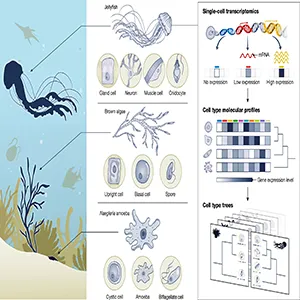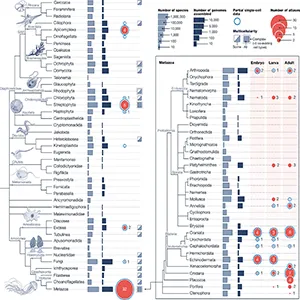
Biodiversity Cell Atlas project is creating a map of every living thing, cell by cell
Imagine trying to understand all of life on Earth by looking not just at whole organisms, but by zooming in to see every kind of cell they’re made of – like building a world atlas, but at the microscopic level. A new project, the Biodiversity Cell Atlas (BCA), now aims to map every different type of cell across all of eukaryotic life.
Life on Earth is dazzling in its variety, yet it’s all made from the same type of building blocks: cells. Every plant, animal, fungus, bacterium or protist depends on these tiny units.
Although scientists can sequence genomes, they don’t fully explain how DNA produces such a wide diversity of cells. That mystery has left a gap in our understanding of life.
Now, by using shared standards and focusing on species with strong genome data, researchers have big plans.
They want to compare cells between species, trace how cell types evolved, and learn new biology that could help areas from ecology to medicine.
The new project to detail the diversity of cellular types is one of the boldest scientific efforts ever attempted, and it could transform conservation, medicine, and even industry.
Biodiversity Cell Atlas begins
The plan appears in Nature and is being driven by the Wellcome Sanger Institute in the U.K., and the Center for Genomic Regulation in Barcelona.
Experts across the world are already involved. The goal is to study life at the single-cell level, comparing cell types and gene expression across species and life stages.
That means scientists will not only know what DNA says but also see how each cell interprets that message. The result could be a living map that shows how cells interact and evolve.
Learning from the past
Genome sequencing has already reshaped biology in the past 25 years. The first human genome draft led to huge leaps in knowledge.
Projects like the Darwin Tree of Life are now sequencing every species in Britain and Ireland. These projects reveal DNA, but they do not explain how genomes create such astonishing cellular diversity.
The Biodiversity Cell Atlas steps into that space. It connects genome data with what cells actually do. That bridge could explain how evolution produced the vast range of cell types found across the planet.

First steps already planned
The project’s early phase will test different protocols for studying single-cell gene expression in many species.
Scientists want to settle on methods that work across the tree of life. Once the process is standardized, data from every corner of the globe can feed into one shared atlas.
This step matters. Results are not comparable without a common framework. With one, discoveries made in a lab in Asia or Africa can link directly to data produced in Europe or the Americas.
The effort demands more than advanced technology. It needs partnerships across biology, genomics, and ecology.
Local communities also have a role to play in ensuring that the benefits of this work are shared equitably. Knowledge about life’s building blocks should not remain in silos but should serve everyone.
Vision of the Biodiversity Cell Atlas
“Understanding the diversity of life demands strong interdisciplinary collaboration,” explained Dr. Arnau Sebé Pedrós, initiator of the Biodiversity Cell Atlas at the Center for Genomic Regulation and Associate Faculty at the Wellcome Sanger Institute.
“By bringing together experts from across the world and creating a framework to coordinate and standardize our efforts, everyone can benefit.”
Dr. Pedrós added that vision of the initiative is to undertake scientific exploration at a large scale, enhance the understanding of evolution and open the door to discoveries that are completely unexpected.

Not starting from scratch
“The first multicellular species with their whole genomes sequenced more than 20 years ago – humans, flies, worms – were incredibly ambitious projects for their time. They changed the course of science in the years to come,” noted Dr. Mara Lawniczak, co-leader of the Biodiversity Cell Atlas efforts at the Wellcome Sanger Institute.
The scientists involved hope that this new initiative will have a similar impact. This level of biological understanding of eukaryotic life could have wide-ranging implications, including in medicine and conservation.
“While we still have a lot to figure out when it comes to processes and techniques, it is incredibly exciting to be involved in such a transformative project,” enthused Lawniczak.
Future of Biodiversity Cell Atlas
The Biodiversity Cell Atlas will collect single-cell data across many organisms, link those data to high-quality genomes, and use common methods so results are comparable.
If successful, the project would reveal which cell features are ancient and shared, how new cell types arise, how cells specialize, and even how different organisms’ cells interact in ecosystems.
In very basic terms, this is a blueprint to systematically map life at cellular resolution – an effort that could transform our understanding of evolution and biodiversity.
Such a resource could change how we conserve endangered species, how we design new medicines, how we explore industrial biology, and how we grasp the story of evolution across time.
What began with sequencing the human genome now expands to charting life, one cell at a time. This will likely open possibilities that were unimaginable only a generation ago.
The study was published in the journal Nature.
—–
Like what you read? Subscribe to our newsletter for engaging articles, exclusive content, and the latest updates.
Check us out on EarthSnap, a free app brought to you by Eric Ralls and Earth.com.
—–













